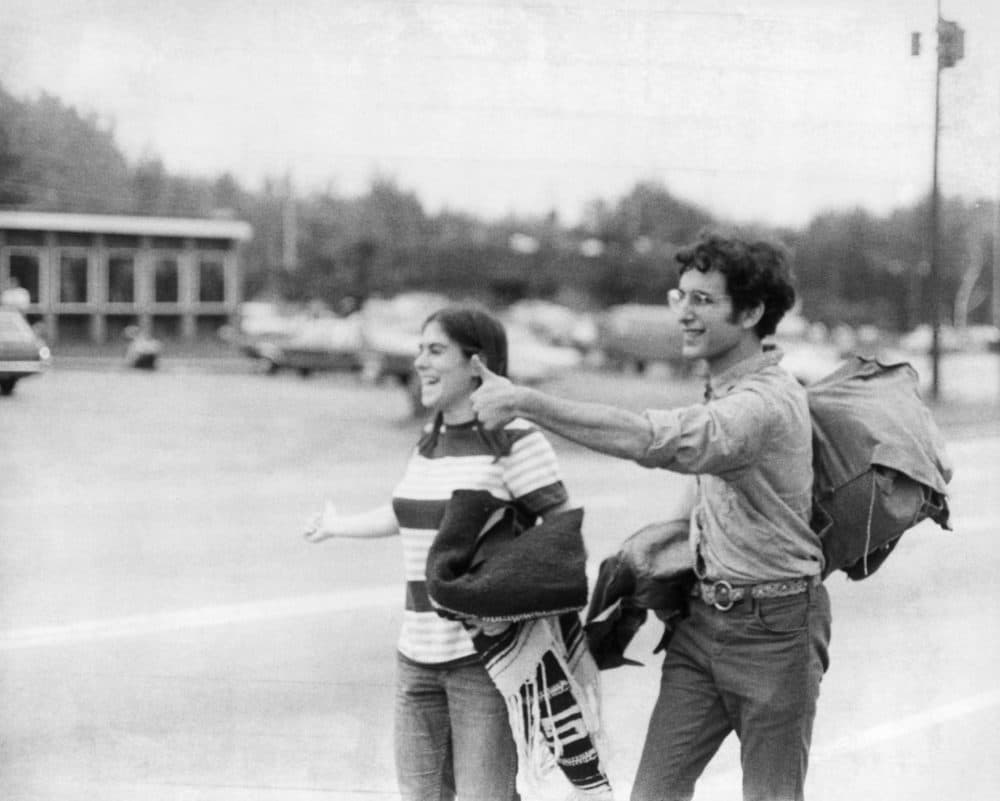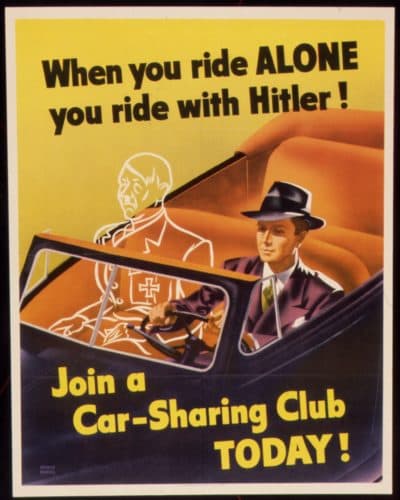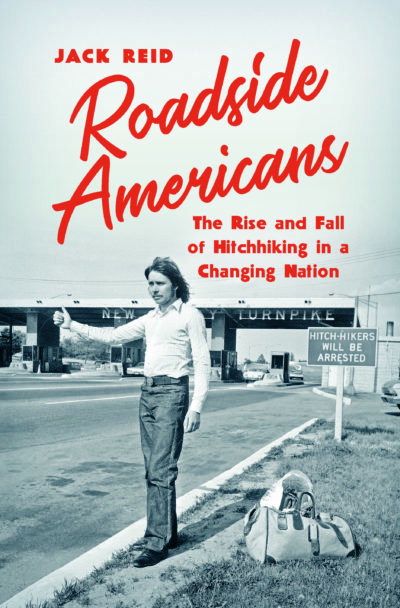Advertisement
Looking At America Through A Hitchhiking Lens
Resume
While most Americans today can’t fathom the thought of hitchhiking, people used to dress up during the Great Depression and World War II to stick out their thumbs on the side of the road.
In his book "Roadside Americans: The Rise and Fall of Hitchhiking in a Changing Nation," American historian Jack Reid chronicles the rise and fall of hitchhiking in the U.S.
Times of economic depression or war led people to seek rides from strangers, he says.
“There were all these different circumstances that were leading people to hitchhike and to understand why hitchhiking was acceptable,” he says.
The rise of individualism in the 1980s led people away from hitchhiking, he says — though calling an Uber or Lyft isn’t much different than getting in a random car on a highway.
Reid says he hopes the coronavirus pandemic will result in Americans standing behind a collective goal once again.
“I am hopeful that there could be a sense of this kind of civic cooperation that may make a return,” he says, ”and some of the ways that we saw Americans rally around a common cause in previous crises in the 20th century.”
Interview Highlights
On how hitchhiking became popular
“Hitchhiking was really common in the 1930s and 1940s. And then there's a bit of a dip in the 1950s and a big resurgence in the ‘60s and ‘70s. And in the ‘30s and ‘40s, hitchhiking was really associated with necessity. And so in the Depression, there were people out of work and trying to find opportunity. And not everyone owned an automobile at that time. So people would take to the road in search of opportunity and work. And people just saw, ‘OK, this person's trying to get over there and I understand that. I'll give them a ride.’
“And then in World War II, there were these gasoline and tire restrictions. And so people recognized that things have changed. We can't just drive everywhere we want. And at the same time, you have American servicemen who were trying to get back and forth from their base to their homes to see family and friends.
“Once the country moved out of that kind of sense of crisis in the 1950s, hitchhiking's popularity and acceptance waned a little bit. But then you had this whole generation of young people who kind of felt confined by a sense of suburban comfort and wanted to explore and get a more authentic sense of what the world is about. And so you have young people hitchhiking for adventure, people reading on the road and wanting to get out and explore the world and meet a whole cross-section of people that wouldn't otherwise.”
On why the popularity of hitchhiking declined
“By the ‘80s, you know, you had this sense of change. The economy had shifted. People were more interested in individualism and not really the sense of like the whole hippie ethos of cooperation. ‘We can do this together’ really lost favor and you have people far more interested in kind of looking out for themselves. And, you know, hitchhiking just kind of went by the wayside.”
On Uber and Lyft
“It's a commodified version of [hitchhiking]. But I don't think people really associate it with hitchhiking, which is interesting because yeah, these people don't have chauffeur's licenses. They're not taxi drivers. They're just someone in their car coming to pick you up. And I guess we have the filter of technology which is showing us like this mass system of ‘Well, other people have ridden with them and given them high marks. So I guess I'm OK.’ It's still at the root, you know, a stranger coming to pick you up.”
On what he thinks COVID-19 could change
“It'll be interesting to see how this plays out because something that's as deeply seated as like handshaking in our culture, if we don't do that for six months, what's that going to look like moving forward? Will people still feel comfortable handshaking or will we go more toward a wave? What will that look like? I also like thinking, the optimist in me, what could positively grow out of this? And looking back to my book, I talked about the Great Depression and World War II and how this collective sense of crises that emerged during this time period led to people kind of circling the wagons and kind of fighting for a common cause.”

On a World War II government poster that said “When you ride alone, you ride with Hitler”
“I think it's kind of like social programming in some ways because, you know, Americans had felt entitled like, ‘I can drive my own car, I'm fine.’ But I think those kinds of posters were just trying to urge people and put things in perspective of what's at stake here. Yes, you are used to driving alone, but now you're gonna have to do something different. And that played out in all different kinds of ways. And there's a great deal of volunteerism. During World War II, you know, people planting gardens. And I think you'll see some of that come out in this time period because we are definitely in unchartered territory in some ways with this pandemic.”
Emiko Tamagawa produced and edited this interview for broadcast with Tinku Ray. Allison Hagan adapted it for the web.
Excerpt From 'Roadside Americans'
INTRODUCTION
You Never Have to Drive Very Far to Find a Hitchhiker
THE YEAR WAS 1932. A well-dressed young man stood next to the highway outside Dixon, Illinois, in the sweltering August heat. Looking up from the yellowed grass, he fixed his gaze to the west. He had spent the months since college graduation traveling from town to town in the hopes of landing a radio broadcasting job. With no luck thus far, he set his sights on Davenport, Iowa. Maybe there his fortunes would improve. Taking a deep breath, he stuck out his thumb and waited for the ride that would help him find work during the leanest year of the Great Depression.

That the young man was hitchhiking was nothing out of the ordinary—people did so all the time during the Depression years. What makes this story noteworthy is that he would someday become president. Ronald Reagan had long relied on hitchhiking as a thrifty way to travel back and forth between his hometown and college. On this trip he found success: once in Davenport, Reagan earned a sports broadcasting position at WHO Radio, a job he kept for the next five years. Decades later, in the months leading up to his reelection in 1984, Reagan returned to the station for an interview. WHO radio personality Jim Zabel harkened back to the day Reagan had traveled to Iowa in search of a job, calling the young man’s hitchhiking journey a “true American hero story.”1
Far from being heroic, hitchhiking was once was a common form of mobility for students and travelers of all ages. This held true from the Depression era, when those seeking work could find transportation by sticking out a thumb, through to the early 1970s, when one writer observed, “You never have to drive very far to find a hitchhiker.” Yet by the time Reagan reached the White House, hitchhiking had lost traction. Although Zabel could wax nostalgic, painting the president’s journey as part of the nation’s wholesome past, in the 1980s few Americans saw hitchhikers as heroic. To them, hitchhiking was a taboo form of mobility reserved for desperate and often unsavory individuals.
Not much has changed since then. Most young college students today would never think to hitchhike the two-hour distance between home and university. Even adventurous souls looking to explore the country and beyond on a shoestring budget rarely consider the practice. Motorists see the occasional thumber as a confusing anachronism: “A hitchhiker? I didn’t know people still did that.”3Although many people today characterize hitchhiking as completely irrational and dangerous, the practice was common not that long ago. For baby boomers who came of age in the 1970s, for instance, thumbing was routine. Even people who did not hitchhike themselves certainly knew those who did. It’s not just that a key form of mobility has all but disappeared: Americans’ sense of trust has seemingly disappeared with it, and with remarkable speed.
What happened? Why did the once ubiquitous act of soliciting rides from a passing vehicle lose acceptance? When I pose this question in casual conversations, people often suggest that there is no longer a need to thumb rides. Perhaps, but in the sixties and early seventies, when automobility was also widespread, people still wanted to hitchhike. Others contend that over time it became too dangerous. Yet the crime blotters in newspapers from the 1930s or 1940s—supposedly safe periods of hitchhiking—suggest that thumbing a ride has always carried a degree of danger. Something else has changed about America, something a lot more sweeping than rates of car ownership or crime.
Between the Great Depression and Ronald Reagan’s two terms as president, a broader set of cultural and historical changes occurred. Not just increasing automobile ownership but larger social and political changes combined to alter the identity of those on the road, painting them as untrustworthy and dangerous transients and darkening the discourse surrounding hitchhiking. This story is in many ways the history of the fracturing of the liberal New Deal social order and the rise of a more conservative national climate in the 1980s.
Close attention reveals that from its early days, thumbing a ride was always a contested form of mobility. Some critics during the Depression feared that hitchhiking had the potential to fuel a freewheeling something-for-nothing attitude, undermining the Protestant ethic and traditional understandings of family and community responsibility. To allay these fears, many hitchhikers between the Depression and the mid-1960s attempted to distinguish themselves from tramps by projecting a responsible, clean-cut appearance in line with mainstream values. Challenges to this conventional worldview, in the form of the civil rights, counterculture, and feminist movements, however, recalibrated the identity of those on the road and, in turn, the nation’s understanding of hitchhiking. Young hippies, or self-identified freaks, did not care about disassociating themselves from tramps. They saw what they called “thumb tripping” as both a pathway toward authentic experience and a practical vehicle for living out the politicized counterculture’s rejection of traditional values. At the same time, feminists seeking to overturn patriarchal attitudes, saw hitchhiking as a means toward forging a more liberated sense of personal mobility. African Americans and other racial minorities likewise pushed the boundaries that constricted their mobility via the thumb. Several cultural trends, including the counterculture’s sizable footprint in the early to mid-1970s, led hitchhiking to explode in popularity despite vigorous anti-hitchhiking campaigns mounted by law enforcement agencies, local governments, the media, and private organizations.
Yet as the counterculture waned amid the concurrent rise of the conservative movement and law-and-order politics in the late 1970s and 1980s, hitchhiking lost legitimacy. In the minds of many Americans thumbing a ride was now linked to subversive and irresponsible behavior, crime, promiscuous sexuality, and casual drug use; critics began to associate ride solicitation with broader fears of social decay. Even participation among young people, previously the bedrock of the hitchhiking community, eroded substantially as the romance of thumb tripping ebbed. At the same time, economic recession and deindustrialization in the early 1980s fueled the emergence of an increasingly large homeless population, some of whom took to the road in search of opportunity. These individuals faced strikingly different circumstances than their Depression-era counterparts. In a society increasingly preoccupied with individual well-being and safety, motorists offered little sympathy to homeless individuals on the road, deemed “drifters” by social critics.
From Roadside Americans: The Rise and Fall of Hitchhiking in a Changing Nation by Jack Reid. Copyright © 2020 by the University of North Carolina Press. Used by permission of the publisher.
This segment aired on April 8, 2020.
